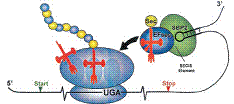Biochemistry, Department of

Vadim Gladyshev Publications
Document Type
Article
Date of this Version
February 2006
Abstract
Selenium has significant health benefits, including potent cancer prevention activity and roles in immune function and the male reproductive system. Selenium-containing proteins, which incorporate this essential micronutrient as selenocysteine, are proposed to mediate the positive effects of dietary selenium. Presented here are the solution NMR structures of the selenoprotein SelM and an ortholog of the selenoprotein Sep15. These data reveal that Sep15 and SelM are structural homologs that establish a new thioredoxinlike protein family. The location of the active-site redox motifs within the fold together with the observed localized conformational changes after thiol-disulfide exchange and measured redox potential indicate that they have redox activity. In mammals, Sep15 expression is regulated by dietary selenium, and either decreased or increased expression of this selenoprotein alters redox homeostasis. A physiological role for Sep15 and SelM as thiol-disulfide oxidoreductases and their contribution to the quality control pathways of the endoplasmic reticulum are discussed.


Comments
Published in Journal of Biological Chemistry 281:6 (February 10, 2006), pp. 3536-3543. Copyright © 2006 by The American Society for Biochemistry and Molecular Biology, Inc. Used by permission.